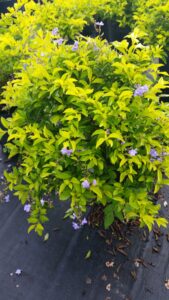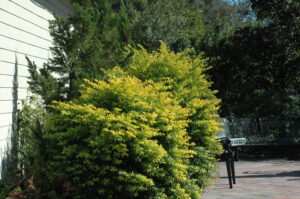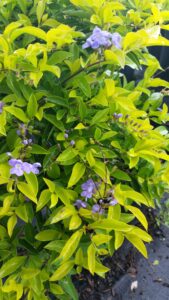S & J Nursery’s Guide to Growing
Gold Mound Duranta / Gold Leaf Golden Dew Drop
in the Northeast Florida
Jacksonville|St. Augustine area Landscape
( Duranta erecta ‘Gold Mound’ )

Gold Mound Duranta / Duranta erecta Origins:
– Native to the West Indies / Centreal America and possibly the Flroida Keys. Gold Mound Duranta plants are a shrubby perennial tropical plant selection. Foliage is hardy in zones 10-11 and plants are root hardy in subtropical climate zones such as Northeast Florida zone 9A – 9B, you may loose this plant altogether in the landscape and should be treated as an annual in colder areas of NE Florida ( North side Jax / West Side Jax. / Airport / Hilliard etc. zone 8b.
– Cultivated for their intense foliage new growth that adds an easy maintenance pop of color in the landscape.
Sun Exposure for the Gold Mound Duranta / Durant erecta:
– Gold Mound Duranta plants are best planted in areas that will
receive full or partial sun. Morning shade and afternoon sun is also an ideal situation for this plant as the structure or landscape causing the morning shade may also help protect them in the winter season from harsh frosts allowing them to regrow quickly in the spring. In Northeast Florida, a plant receiving 6 hours or more of sun exposure is considered to be planted in a full sun location. So for that reason morning shade and afternoon sun is ideal in cooler areas of NE Florida. Filtered light under taller growing shade trees works as well but if you get to much shade you loose much of that bright color that you selected the plant for in the first place.
– Best if planted on the south side of the house away from cold north winds, up next to a fence or near the foundation of a home or other building, or near larger shade trees that will protect these tropical plants from frost. Or plant on the west side of a home or building.

Foliage of the Gold Mound Duranta:
– A very unpretentious looking plant for having such a stunning smell, they blend right in among other foundation shrubs with light to medium green large leaves that can be from 4-8 inches long. Well, they blend in until they begin to bloom!
– Foliage will damage during the winter in our Northeast Florida area gardens when temperatures reach 32 degrees and foliage and stems will damage with temperatures below freezing. But will quickly regrow from its roots the following spring in the Jacksonville and St. Augustine area gardens. As with all tropical plantings, they are particularly responsive to their individual planting location. When planted on the south side of the house away from north winds, or where receiving some frost protection from larger trees or nearby buildings.
Soil Preference / Salt tolerance of the Gold Mound Duranta :
– Gold Mound plants are at home in our Northeast Florida’s sandy soils and are fairly drought tolerant once established into the landscape. While they are not particular about the components of the soil they are planted into they can still benefit from soil amendment at planting time. Amending sandy soil with compost compost to help your Jacksonville and St. Augustine area soil hold both water and nutrients and get them rooted and growing keep your plants healthy and blooming only use 1/3rd amendment to 2/3 native soil to backfill your planting hole unless amending the entire bed area.
– Gold Mound is considered TO NOT BE SALT TOLERANT.
Size Variance of Gold Mound Duranta:
UFIFAS also list Gold Mound Duranta in their extension office as 2–3 ft tall and wide plants. Just so you don’t think Im crazy you can see that here….
https://edis.ifas.ufl.edu/pdffiles/fr/fr32700.pdf
In fact, most garden bloggers and nursery websites, garden books etc. will list gold mound as a shrub height of 2-3 ft, some will ignore the height altogether and just say it should be kept at such and such height. So WHAT IS THAT? Well, Gold Mound is a shrubby perennial plant that happens to stay pretty short during the first part of its life span but can when planted into its ideal planting zones farther south from us or in the perfect protected spot, get rather large with age. As you can see here with this photo ( taken in North Florida) these gold Mound got much closer to 5-6 ft tall. Most shrubs in our area will not reach this kind of heights, but it can happen and it would be best top know that you will need to keep them trimmed annually if they are planted in an area where the cold doesn’t nip them back for you each winter. If you never knew they had the potential to get larger why would you think to trim them? Right? Ok, so I have done my due diligence and can sleep at night, I do see why most people just leave them as the height they are most commonly seen growing at and do in fact recommend them for shorter plant selections frequently. They are, in fact, most often recommended and used as low slow growing front layer of the foundation planting option in the landscape.

Growth Habit of the Gold Mound Duranta:
– Rounded mounding habit when young and a wider spreading almost weeping habit with age.
– Responds well to harsh pruning, so don’t be afraid to cut them
back and keep them nice and tidy!
Growth Rate of the Gold Mound Duranta :
–Moderate expect 6 inches of growth each year.
Blooms / Berries of the Gold Mound Duranta:
– Blooms on an off a few times each year if conditions are favorable during late summer followed by golden berries in the fall. Blooms are born in clusters at branch tips and are a light lavender blue color. Berries are teardrop shaped and a bright golden color.

Water Requirements of Gold Mound Duranta:
– Although much more durable and drought tolerant once established in the landscape, regular water is necessary to get the plant rooted and growing on its own after being planted in the ground from an S & J Nursery container. Water every day for the first week then every other day for the next week, and continue to taper watering black to a minimum of once a week or every time the top 2 inches of the soil is dry to the touch. Fully rooted and established cestrum plants are moderately drought tolerant and should only need supplemental irrigation in times of drought.
Watering Your Newly Planted Shrubs
Best Uses For Gold Mound in the Jacksonville | St. Augustine Area Landscapes :
– Duranta plants can be used in foundation plantings, as an accent to bring color to a specific area of the garden and make wonderful additions to perennial gardens and mixed container plantings as well.
Care of Gold Mound Duranta in the Northeast Florida Landscape:
– Water every day during the establishment period after planting in the garden from an S & J Nursery container. Be sure to continue supplemental irrigation during the hot summer months during prolonged grouts.
– Fertilize each year just after trimming in the spring with a good shovel full of garden compost or use Osmocote or another slow release plant food spring, summer and fall.
– When temperatures drop below 30 degrees you may opt to protect your foliage and stems from severe frost damage by throwing a blanket or other breathable fabric over the top of the plant making sure the edges touch the ground to trap in the heat from the soil.
– Make your last summer pruning in August giving your night blooming
jasmine plant ample time to recover new foliage that will harden off before winter arrives for us here in late December. Pruning to late into the fall will cause flushes of cold sensitive new growth that is sure to freeze during even a light frost that hardened off foliage would not be affected by.
– DO NOT REMOVE BURNT FOLIAGE UNTIL ALL DANGER OF FROST HAS PASSED. Be sure not to remove any stems or leaves from the plant until we have reached the last average frost date and there are no late freezes being predicted. ( mid February for Northeast Florida is the average last frost date) Trimming burnt foliage and stems before then will leave bare branches deeper on the plant exposed to cold temperatures that would have been protected by those same stems and foliage if left unpruned and most often results in loss of the plant entirely.

